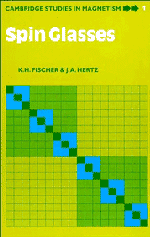Book contents
- Frontmatter
- Contents
- Preface
- 1 Introduction
- 2 Models, order parameters, and systems
- 3 Mean field theory I: Ising model, equilibrium theory
- 4 Introduction to dynamics
- 5 Mean field theory II: Ising dynamics
- 6 Mean field theory III: vector spins
- 7 Short-range interactions: low-temperature properties
- 8 Beyond mean field theory
- 9 Dynamics on many time scales
- 10 Specific heat, sound propagation, and transport properties
- 11 Competition between spin glass and ferromagnetic or antiferromagnetic order
- 12 One-dimensional models
- 13 Random field and random anisotropy
- 14 The physics of complexity
- 15 A short history of spin glasses
- References
- Index
3 - Mean field theory I: Ising model, equilibrium theory
Published online by Cambridge University Press: 01 June 2011
- Frontmatter
- Contents
- Preface
- 1 Introduction
- 2 Models, order parameters, and systems
- 3 Mean field theory I: Ising model, equilibrium theory
- 4 Introduction to dynamics
- 5 Mean field theory II: Ising dynamics
- 6 Mean field theory III: vector spins
- 7 Short-range interactions: low-temperature properties
- 8 Beyond mean field theory
- 9 Dynamics on many time scales
- 10 Specific heat, sound propagation, and transport properties
- 11 Competition between spin glass and ferromagnetic or antiferromagnetic order
- 12 One-dimensional models
- 13 Random field and random anisotropy
- 14 The physics of complexity
- 15 A short history of spin glasses
- References
- Index
Summary
In this chapter we will put the concepts we have developed in Chapter 2 to work in constructing the mean field theory for an Ising spin glass. The term ‘mean field theory’ (henceforth frequently abbreviated ‘MFT’) can be interpreted in many ways. Here we will take it to mean the exact solution of a model in which the forces are of infinitely long range, so that each spin interacts equally strongly with every other one. For spin glasses, this is the Sherrington–Kirkpatrick (SK) model (1975), which we solve heuristically (though unfortunately incorrectly) in Section 3.1. The error is a somewhat subtle one, as is evident from the fact that we obtain exactly the same result in the more systematic calculations of Sections 3.2 (a direct summation of the leading terms in N−1 in high-temperature perturbation theory) and 3.3 (which uses the replica formalism). In both these approaches, we can also see how the theory itself reveals that it is wrong, since they lead to negative values of quantities which are necessarily positive.
We then study the correct mean field theory, with replica symmetry breaking, in Section 3.4, including the remarkable nature of the broken ergodicity it implies and an examination of its stability. Further physical insight into the problem is obtained in Section 3.5 from the mean field equations first introduced by Thouless, Anderson and Palmer (TAP) (1977).
- Type
- Chapter
- Information
- Spin Glasses , pp. 61 - 124Publisher: Cambridge University PressPrint publication year: 1991



